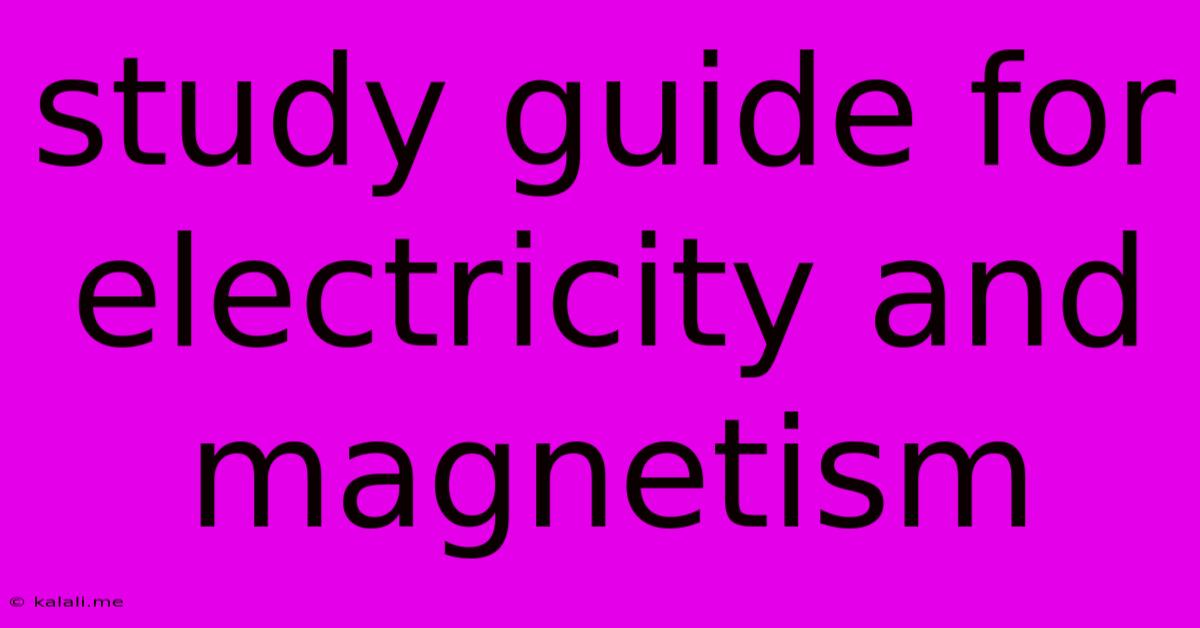Study Guide For Electricity And Magnetism
Kalali
May 09, 2025 · 4 min read

Table of Contents
Conquer Electricity and Magnetism: A Comprehensive Study Guide
This study guide provides a structured approach to mastering the concepts of electricity and magnetism, crucial topics in physics. Understanding these principles is essential for various fields, from electrical engineering to medical imaging. We'll cover key concepts, problem-solving strategies, and resources to help you excel. This guide is designed for students of all levels, from introductory physics to advanced coursework.
What is Electricity and Magnetism?
Electricity and magnetism are intertwined phenomena described by electromagnetism. Electricity deals with stationary or moving electric charges, resulting in electric fields and currents. Magnetism involves magnetic fields produced by moving charges or magnetic materials. This interconnectedness is beautifully exemplified by the fact that moving charges create magnetic fields, and changing magnetic fields induce electric currents (electromagnetic induction). Understanding this fundamental relationship is key to grasping the entire subject.
Key Concepts to Master:
This section outlines the essential concepts you must understand to succeed in your study of electricity and magnetism.
1. Electric Charges and Fields:
- Coulomb's Law: This foundational law describes the force between two point charges. Understanding its implications, including the inverse square relationship, is crucial. Practice calculating the force between charges given their magnitudes and separation.
- Electric Fields: Learn how to visualize and calculate electric fields, both from point charges and charge distributions. Master the concept of electric field lines and their representation.
- Electric Potential and Potential Energy: Grasp the relationship between electric potential and electric field. Practice calculating potential difference and potential energy of charges within electric fields. Understand equipotential surfaces.
- Gauss's Law: This powerful law relates the electric flux through a closed surface to the enclosed charge. Understanding its application to various symmetrical charge distributions is essential.
2. Electric Current and Circuits:
- Ohm's Law: This simple yet fundamental law describes the relationship between voltage, current, and resistance in a circuit. Master its applications in various circuit configurations.
- Circuit Analysis: Become proficient in analyzing simple and complex circuits using techniques like Kirchhoff's laws. Learn how to calculate current, voltage, and resistance in different parts of a circuit.
- Capacitance and Inductance: Understand how capacitors and inductors store energy in electric and magnetic fields, respectively. Learn their behavior in DC and AC circuits.
- DC and AC Circuits: Differentiate between direct current (DC) and alternating current (AC) circuits and their characteristics.
3. Magnetism and Magnetic Fields:
- Magnetic Force: Learn how magnetic fields exert forces on moving charges and current-carrying wires. Understand the right-hand rule for determining the direction of the force.
- Magnetic Field Sources: Understand how magnetic fields are generated by moving charges, permanent magnets, and electromagnets. Learn about magnetic dipoles and their properties.
- Ampere's Law: This law relates the magnetic field around a closed loop to the current enclosed by the loop. Understanding its application is crucial for calculating magnetic fields due to various current configurations.
- Faraday's Law of Induction: This law describes how a changing magnetic field induces an electromotive force (EMF) in a conductor. Understand the concept of electromagnetic induction and its applications, such as transformers and generators.
4. Electromagnetic Waves:
- Electromagnetic Spectrum: Understand the different types of electromagnetic waves, their properties, and their applications.
- Wave Properties: Review wave properties like wavelength, frequency, speed, and amplitude. Understand how these properties relate to each other for electromagnetic waves.
- Maxwell's Equations: While a deeper understanding requires advanced study, familiarize yourself with the significance of Maxwell's equations in unifying electricity and magnetism.
Effective Study Strategies:
- Active Recall: Test yourself regularly using flashcards, practice problems, and self-quizzes. Don't just passively reread your notes.
- Concept Mapping: Create diagrams to visually represent the relationships between different concepts.
- Problem Solving: Practice a wide variety of problems, starting with simple ones and gradually increasing the complexity. Focus on understanding the underlying principles, not just memorizing formulas.
- Seek Help: Don't hesitate to ask your instructor, teaching assistant, or classmates for help if you are struggling with a particular concept.
Recommended Resources:
While specific textbooks vary depending on your course, most introductory physics textbooks dedicate significant portions to electricity and magnetism. Supplement your textbook with online resources, such as Khan Academy and educational YouTube channels, for additional explanations and practice problems.
By diligently following this study guide and employing effective learning strategies, you can build a solid understanding of electricity and magnetism and achieve success in your studies. Remember, consistent effort and a focus on understanding the underlying principles are key to mastering this fascinating and important area of physics.
Latest Posts
Latest Posts
-
Jaguar Adaptations In The Tropical Rainforest
May 10, 2025
-
How To Find Average Velocity From Velocity Time Graph
May 10, 2025
-
What Is Non Living Things In The Ecosystem
May 10, 2025
-
How Many Fl Oz In 6 Cups
May 10, 2025
-
What Is 1 Percent Of 5000
May 10, 2025
Related Post
Thank you for visiting our website which covers about Study Guide For Electricity And Magnetism . We hope the information provided has been useful to you. Feel free to contact us if you have any questions or need further assistance. See you next time and don't miss to bookmark.